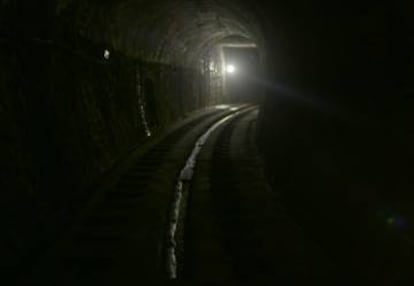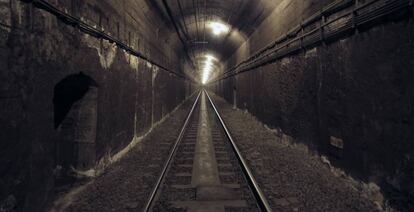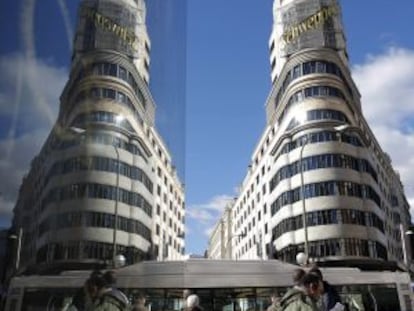Madrid¡¯s forgotten Metro lines
Deep under the capital are disused stations and abandoned tunnels dating back to the 1930s
Madrid¡¯s Metro system is a world unto itself: 294 kilometers of track, 301 stations and 13 lines, through which travel some 2,318 trains each day, carrying around two million passengers. There are also four tunnels that are not in use: one, at Chamart¨ªn, the high-speed train station in the north of the city, was built as the starting point for a north-south axis that was never completed.
Two more, one close to Moncloa in the west of the city and another between Nuevos Ministerios and Avenida de ?merica to the north, may be familiar to older residents. The fourth is an annex of Goya, in the upscale Salamanca neighborhood, which was built in the 1930s, but has been abandoned for the last six decades.

Hidden in plain sight on the northbound platform of Line 2 at Goya station is a metal door, and behind it a passageway that, until 1958, led to a one-way track to nearby Diego de Le¨®n station. It ceased to be used after the inauguration of Line 4, which originally connected Diego de Le¨®n with Arg¨¹elles in the west of the city.
It¡¯s still possible to catch a glimpse of the tunnel aboard trains arriving at Goya from Lista: it¡¯s on the left, just before the entrance to the station. Until the 1990s, its platform was used as a storage area. In its day, this was where a workforce of up to 60 men would carry bags filled with coins from the ticket machines.
Line 3 originally ran between Sol and Embajadores, and was opened on August 9, 1936, less than a month after the start of the Spanish civil war
The 170-meter-long tunnel is well maintained and is a perfect example of the trench method used to build many of the early stretches of Madrid¡¯s Metro system. Along one side is a beautifully preserved pumping well, along with other air vents and the cavities dug into the side of the tunnel where maintenance staff would shelter as trains passed by.

Line 3 originally ran between Sol and Embajadores, and was opened on August 9, 1936, less than a month after the start of the Spanish Civil War. It was extended westward to Arg¨¹elles in 1941 and south to Legazpi a decade later. The final stretch between Arg¨¹elles and Moncloa took another 12 years to complete.
In 2006, lines 3 and 6 were incorporated into the Moncloa transport hub. The new Line 3 station is a little further south than its predecessor, which has been hidden behind a wall. But 550 meters of the old track are hidden in a stretch that can only be accessed by Metro staff via a door on the platform.
When Line 1 was extended to Chamart¨ªn in 2007, the plan was to create a new stretch of Line 11. This would have involved building some 15 kilometers of new tunnel. The plans were dropped the following year after Spain¡¯s economy went into recession. All that is left is about half-a-kilometer of tunnel running northward to nowhere.

Until Madrid City Hall decides whether to resume work, the platform at Chamart¨ªn has been asphalted and is now used by vehicle manufacturers to launch new models.
At 3am, Avenida de Am¨¦rica station is empty, making it possible to clamber down on to the tracks, where, 250 meters to the west, the extension begun in 1999 toward Pitis opens up. To the right is another tunnel.
The track was in use between 1986 and 1996, but today is used for maintenance.
Despite the abandonment of the line, there are echoes of human activity everywhere. On one of the walls, someone has written in large latters the word ¡°Negredo.¡± Who knows whether it is a homage to a family surname, or testament of admiration of the Valencia soccer player. It¡¯s just another mystery to add to the stories of the forgotten tunnels of the Madrid Metro.

English version by Nick Lyne.
Sign up for our newsletter!
EL PA?S English Edition is launching a weekly newsletter. Sign up today to receive a selection of our best stories in your inbox every Saturday morning. For full details about how to subscribe, click here.
Tu suscripci¨®n se est¨¢ usando en otro dispositivo
?Quieres a?adir otro usuario a tu suscripci¨®n?
Si contin¨²as leyendo en este dispositivo, no se podr¨¢ leer en el otro.
FlechaTu suscripci¨®n se est¨¢ usando en otro dispositivo y solo puedes acceder a EL PA?S desde un dispositivo a la vez.
Si quieres compartir tu cuenta, cambia tu suscripci¨®n a la modalidad Premium, as¨ª podr¨¢s a?adir otro usuario. Cada uno acceder¨¢ con su propia cuenta de email, lo que os permitir¨¢ personalizar vuestra experiencia en EL PA?S.
?Tienes una suscripci¨®n de empresa? Accede aqu¨ª para contratar m¨¢s cuentas.
En el caso de no saber qui¨¦n est¨¢ usando tu cuenta, te recomendamos cambiar tu contrase?a aqu¨ª.
Si decides continuar compartiendo tu cuenta, este mensaje se mostrar¨¢ en tu dispositivo y en el de la otra persona que est¨¢ usando tu cuenta de forma indefinida, afectando a tu experiencia de lectura. Puedes consultar aqu¨ª los t¨¦rminos y condiciones de la suscripci¨®n digital.











































